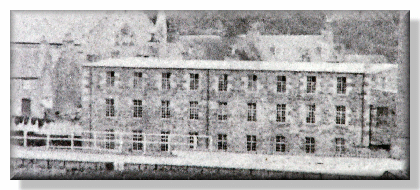
As early as 1740 there was a “walk” mill in Avoch and by 1790 there were 22 weavers in the village. However, over the next fifty years this number dropped to six. By 1851 there were seventeen spinners and only two weavers.

In 1854, Geddes Mill, the woollen factory which can be seen here, was opened by Alexander George Mackenzie, the son of Sir Alexander Mackenzie. The mill was an enterprise which it was hoped would keep the fisherfolk employed during the “off season”. After the death of his mother, Lady Geddes Mackenzie, in 1860, the tenancy of the mill passed to John Shaw, an Englishman. It employed 67 people in total including 9 wool sorters, 16 power loom weavers, 3 woollen cloth teasers, 5 wool spinners and a dyer. Alexander George Mackenzie may have still owned the mill because in the 1868/69 valuation rolls he was entered alongside Smith as “occupier”.

The fortunes of the mill did not prosper however, as three years later it had only 4 weavers, 2 wool spinners and 2 mill servants. Industrialisation did not come easily to the fishing people of Avoch – a far remove from the fishing grounds. It is possible that at this time the mill was passed along with Avoch estate to James Fletcher, who is recorded as having feued the factory to one Alexander Austin in 1877. Austin does not seem to have been too interested in the mill, or maybe he had the same problem as Mr Mackenzie because the building was untenanted from 1882 to 1886.
At this time the mill passed from James Fletcher snr to James Douglas Fletcher jnr who subsequently let it to a resident of Ardgowan, Geddestown – William Grant, for £30 a year. William Grant ran the factory for four years until Fletcher formed the Avoch Tweed Mill Company, with Grant as Manager under the auspices of John Henderson, factor of the Estate.
At the turn of the century, managerial changes were made but the mill kept running until 1908 under a man called Scott, a weaver who also lived in Geddestown at Ardgowan House. So it seems that Grant had left, and the weaver installed in his place. In 1908 the building was reorganised into living accommodation which had no running water and outside “privvies”. In 1911 it was recorded that “factory buildings” had accommodation for 14 families, and it continued as such until the late 1940s when it became derelict and eventually had to be demolished in the decade following.

